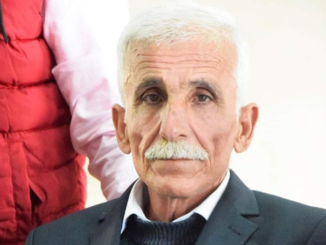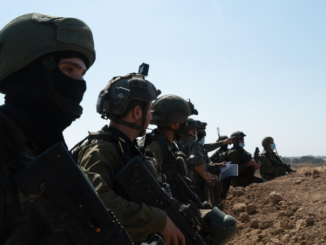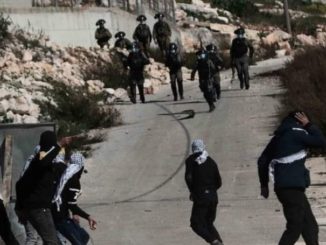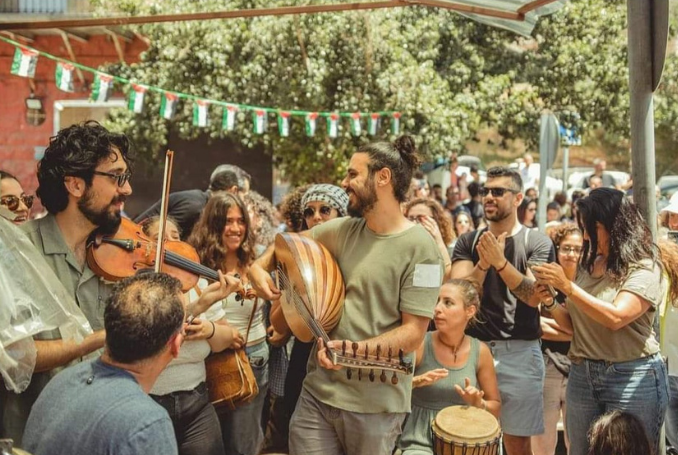
As the May 2021 rebellion across historic Palestine struck back at colonialist violence and ripped apart the artificial seams of a terrorized, subordinate coexistence, two worlds came into view, colliding in physical confrontation and revelation of two diametrically divergent futures of barbarity and social revolution.
Resistance and music joined hands, while Zionism faltered and failed. It could obliterate spaces for performance and culture alongside hospitals, homes and human beings, but al-‘ushaq, those who fight with love for the land, would prevail and sing anew.
This triumph of people power was epitomized in words appearing in the drawing of martyred cartoonist Naji al-Ali, sung in versions by Rola Azar, Samah Mustafa and Mohammed Assaf, in degrees of physical separation from Palestine: “If my voice is silenced, do not silence your voices.”
In the Unity Intifada, Palestinians took to the streets in song, art and political organization. While Israel bombed Gaza, destroying al-Mashriq music studio and around 40 other cultural institutions, the youth sang defiantly in the rubble. “Mawtini,” “‘Aaba Majdaka”… many of the songs had been sung before three years earlier by Mohammad Okasha and other shabab in the ruins of the Said al-Mashal theatre and cultural center after its obliteration in August 2018.
But as Samaa Abu Sharar writes, voicing popular sentiment, May 2021 felt different. Canaan Ghoul led a sung protest of Sheikh Jarrah residents on 8 May – a street sahra of the masses, or a late-night sitting, watched pensively by Zionist troops – and a collectivity rang out across regions that comprador leaders and academics had long consigned to being settled to their fate. In Haifa, Umm al-Fahm, Ramallah and Gaza City, the music of past rebellions rang out, in songs like Walid Abdalsalam’s 1987 intifada anthem “Nzilna ‘a-Shawarya” (‘We went down to the streets’), or Marcel Khalife’s “Shiddu il-Himma,” a song of labor, struggle and return. Renowned musicians became part of the mass during the 18 May general strike, with streets turned into Palestinian festivals of music and revolution.
Following histories of guerrilla music-making, songs were recorded and quickly transmitted by performers keen to take a stand. Sanaa Moussa sang “Sawtoka Ya Shaabi” (‘Your voice, my people’), a Palestinianised arrangement of the Italian protest song Bella Ciao, sampling the speeches of Che Guevara and Nelson Mandela; Maryam Afifi fittingly appeared on double bass, following her violent arrest by Zionist forces in Jerusalem.
In Haifa, a center of renewed hope in Palestinian resistance, the Darbet Shams band sang to oud, guitar and drums a lullaby that saw the origins of regional division in imperialist conquest, demanding: “wipe Skyes-Picot off the map.” In between her involvement in street protests in Jerusalem, Aya Khalaf recorded words made famous by Julia Boutros: “Oh revolutionaries of the land, revolt against tyranny, revolt against hardship.”
The musical flavor of the intifada spread internationally. At a street picket of pro-Israel company M&S in Glasgow, Scotland, Palestinian cellist Tibah Saad sang of steadfastness in “Yama Mwel il-Hawa,” while in Manchester, oud player Reem Anbar performed instrumental messages to lift spirits in Gaza. In the midst of the rising, supporters of the Samidoun prisoners solidarity network collaborated across continents to record “Souli,” with qanoun and traditional percussion filling Khaled Barakat’s poetic call for the right of return with drive and urgency.
From Europe, Nai Barghouti sang “Raja’in” (‘We are returning’), listing Palestinian towns and villages and evoking the joy and celebration of traditional weddings. Contrasting the vivacity of those taking to the streets with the dead-end of capitalist social media, Samidoun and Nai’s songs were censored by Youtube. But despite everything, a century of cultural genocide had failed to erase and silence the people.
It would be an easy task to list the defining, musical moments of this intifada or, in the style of trendy music journalists and curators, number the prominent Palestinian musicians that listeners “need to hear.” Late communist Carol Brickley observed that “In post-modernist times the way to celebrate a political campaign is first to run it into the ground and then to publish a glossy book about how big it was.”
As a revolutionary, armed and confrontational uprising, the Unity Intifada challenged the liberal respectability of depoliticized, individualist approaches to culture promoted by imperialist and Zionist ruling ideologies. Here was popular consciousness, emerging and demanding that the rights of the whole people be recognized.
Frustrations of the Palestinian crisis had spilled over into music the lead-up to May 2021, in tracks like “Inn ann qad aan aweno” (‘If he groans, its time to take him out’) by Jerusalem rappers Daboor and Shabjdeed, who critiqued those who had “sold the country… talking but doing nothing.” If the martyr Basil al-Araj had been dubbed the “militant intellectual” for his drive towards critical thought and culture alongside revolutionary activism against the Zionist state, the Unity Intifada justified his observation that a new generation, “a new people” had arisen to throw off national oppression and put their hopes in a liberated future. That ‘48 Palestine joined Gaza and partitioned Palestine in resistance answered the warning al-Araj had written inside the prisons of the Palestinian Authority: “do not dream of a world of happiness as long as Israel exists.”
Percussionist Fares Anbar had brought his drumkit to the March of Return in 2018, answering gas canisters and grenades with beats, as Gaza’s bands came together to contribute to the cause. The march itself was a warning shot to those keeping a lid on popular aspirations for resistance and return, seen with renewed urgency in May 2021. One of over 260 Palestinians to be killed by Zionist forces during the uprising, Fadi Washaha, son of buzuq player Rami, was memorialised in the lyrics of Hamza al-Barghouti and the singing of Mohammad Nawahda, continuing a tradition of song which paints struggle in the colours of bravery. Martyrdom would give way to new life and those willing to fight and sing for it.
After protesting on the streets of Nazareth, Rola Azar returned to the words appearing next to Naji al-Ali’s Handala, prophetic and urgent, demanding that the torch be carried anew:
“If the singer is silenced, keep on singing.”
Lenin once wrote that a revolutionary situation is defined through at the historic fissure where the indignation of the oppressed refuse to live in the old way and the ruling class are unable to rule as before. In Palestine, the smoke of the volcanoes continues to rise.
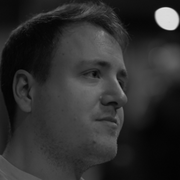
– Louis Brehony is a musician, activist, researcher and educator. He is author of the book Palestinian Music in Exile: Voices of Resistance (2023), editor of Ghassan Kanafani: Selected Political Writings (2024), and director of the award-winning film Kofia: A Revolution Through Music (2021). He writes regularly on Palestine and political culture and performs internationally as a buzuq player and guitarist. He contributed this article to The Palestine Chronicle.



